- Article tells about the nature of Bhil Art, how to
do, what is unique about it and story in brief of Bhuru Bai, a renowned artist,
who was awarded the Padma Shri in 2021.
It
is often said that to know the art form of a particular place, is to know the
place itself. If that is true, then to look at Bhil Art, is to enter the house
of the artists themselves; to experience first-hand, this intimate art form
from Central India.
The
Bhils are the second largest adivasi community in India, residing in Madhya
Pradesh, Gujarat, Maharashtra and Rajasthan. Some Bhils trace their ancestry to
Eklavya, the archer from Mahabharata.
Traditionally,
the art of the Bhil folk would adorn the clay walls of their village homes.
Beautiful images would be painted with neem sticks and other twigs, and natural
dyes would be used. Turmeric, flour, vegetables, leaves and oil were used to
derive brilliant colours to make fascinating frescoes on floors and walls, in a
language created by the Bhils, to convey their experiences.
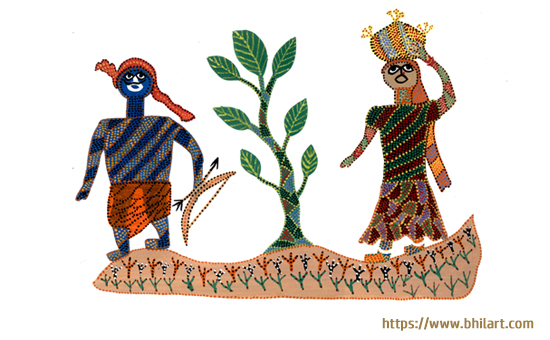 Courtesy bhilart.com
Courtesy bhilart.com
Moving through Dots and Colours
One
look at a Bhil painting, and you will immediately begin to recognize it
anywhere you see the art form. Bhil paintings usually consist of large,
un-lifelike shapes of everyday characters filled with earthy, yet bright
colours, and then covered with an overlay of uniform dots in several patterns
and colours that stand out strikingly against the background.
The
dots on a Bhil painting are not random. They are patterns that could be made to
represent anything that the artists wish to, from ancestors to deities. Because
these patterns are solely in the hands of the artists who create them, the work
of every Bhil artist is unique, and the dot patterns can be counted as the
artist’s signature style.
The
dots are the distinct identity of Bhil art
and have multiple layers of symbolism. Inspired by the kernels of maize - their
staple food and crop - each group of dots often represents a particular
ancestor or deity. Additionally, each artist composes the dots in distinctive
patterns encoding each artwork with signatures visible to the trained eye.
An Honest Depiction of Real Life
Bhil
Art is an instinctive and primordial, born out of an ancient connection with
nature. The Bhils are largely an agricultural community whose lives are centred
around the land they work on. What makes the art extra special, is that it has
travelled down generations, with most artists learning it from their mothers.
Bhil
art is also often ritualistic. Every painting is a story of the land told
through the depictions of people, the animals, the insects, the deities, the festivals.
Even the Sun and Moon are frequent characters in the stories. Legends and lore
are told through Bhil paintings. Births and deaths are recorded. Religious
occasions remembered. These paintings are even offered as gifts to gods and
goddesses at the time of festivals.
Today,
we’re getting to see much more of Bhil art in the mainstream. Clay has been
replaced by canvas, natural dyes with acrylic paints. The artists who would
earlier paint on walls and floors of their village homes, are now recognized
over the country and even internationally.
But
there’s something about this art form that is so rooted, that a change in
medium or even recognition, does not change the honesty of its depictions.
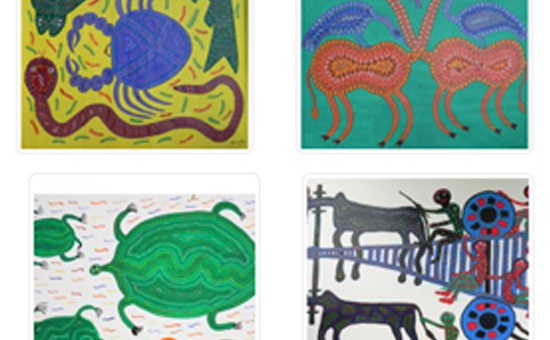 Pic courtesy gallerymuststart.com
Pic courtesy gallerymuststart.com
Let us create Bhil art
People
of all ages should try tribal art. They are bright, simple yet so
detailed. The figures and animals might not be technically perfect but one
should easily understand the motifs and the story behind the painting. See how
animals, trees, birds, humans are nicely tied together to show a village
scene. The community and the culture are beautifully depicted in these
paintings.
Supplies needed
You
would need Watercolour paper or canvas and Acrylic art
supplies. Have a background color on your sheet. Let the paint dry and
then draw something of your choice. Show the figures in action and they should
be bundled together.
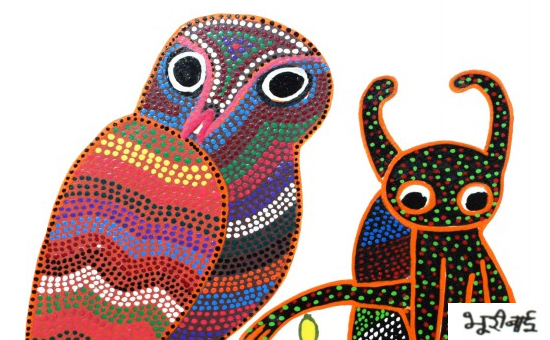 Pic courtesy artsoftheearthindia.in
Pic courtesy artsoftheearthindia.in
Once
you have drawn, start putting the base colors. Since we are using acrylic, you
can easily paint one color above another. Apply two coats till you have a flat
finish. Once the base color has dried, use a thin brush, and start applying
dots in patterns. If you are not comfortable using brushes, you can use acrylic
markers or coloring pens. The dots should be closely packed so the total effect
of the color in that area changes. Slowly complete the entire picture.
What can you learn from Bhil tribal
art?
Think
of your community. Show birds, trees, people, and animals to represent your
surroundings. Paint a happy picture with animals, birds, and people in
action. Paint flat with bright colors. Use the primary and complementary
colors. Do not try mixing colors.
These
paintings represent pointillism art. They are detailed and fill the entire
area. Think of patterns to fill the base.
Fill
and balance the entire picture with colors and figures.
Symbolism of Bhil Art
Bhils
have a primordial relationship with nature
which gives importance to the changing seasons and elemental worship so as to
have a successful harvest. Even the materials used for the painting generally
are naturally obtained pigments, neem twigs as brushes on clay walls, a form of
frescoes (mittichithra).
This
skill was a part of the informal education which has become part of the
cultural identity of the Bhil community. There has also been a gradual
introduction of modern life and technology that has found space in modern
interpretations of Bhil art.
The
simplistic imagery of this art that reflect the purity of nature and life make
imperfections something to be desired and teach us to enjoy the fundamental
symbolism of life.
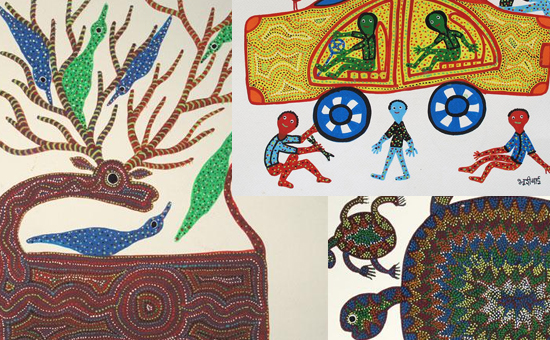 Pic courtesy indigoarts.com
Pic courtesy indigoarts.com
Bhuri Bai: The Pride of India
From
painting on rocks with twigs to having her artwork displayed in UK and USA and
being conferred with a Padma Shri for her immense contributions in preserving
the traditional Pithora art form,
Bhuri Bai from Madhya Pradesh has definitely come a long way.
Madhya
Pradesh-based Bhuri Bai had experienced acute poverty first hand. When she was ten
her house was burnt down in a fire, so her family built a makeshift house from
hay and lived there for years.
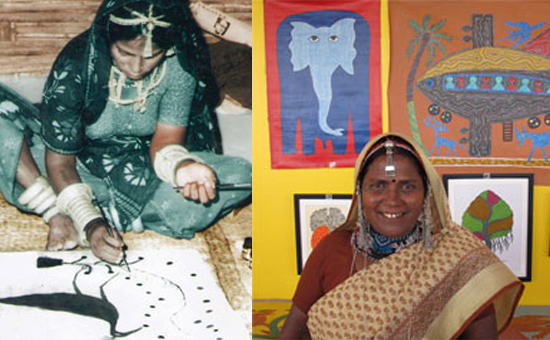 Bhuri Bai. Pic courtesy indigoarts.com
Bhuri Bai. Pic courtesy indigoarts.com
She was a child bride and post-marriage survived on a meagre income of Rs 6 per day. When Bhuri finally found a breakthrough with Pithora painting, an enriched folk art, her Bhil tribe condemned her for it as women weren’t allowed to indulge in art forms. They even played the patriarchal card by suggesting her husband was not man enough to earn as much as Bhuri was earning through her paintings. Notwithstanding this Bhuri continued to move forward and let her innate talent blossom.
When
more than 40 years back, Bhuri Bai, then in her teens, set off for Bhopal from
her village in Jhabua district in search of work, she could not have dreamt that
someday she would become a renowned artist. As luck would have it, she got work
at the construction site of Bharat Bhavan as a labourer, where she came in
contact with painter J. Swaminathan, who spotted her talent. And the rest, as
they say, is history.
The 52-year-old Bhil artist was declared a winner of the Padma Shri this Republic Day. She is also a recipient of the Madhya Pradesh Government's Shikhar Samman, among others. From
Lucknow to London, Mumbai, Delhi, Hyderabad to the United States and the United
Kingdom, her paintings have travelled far and wide.
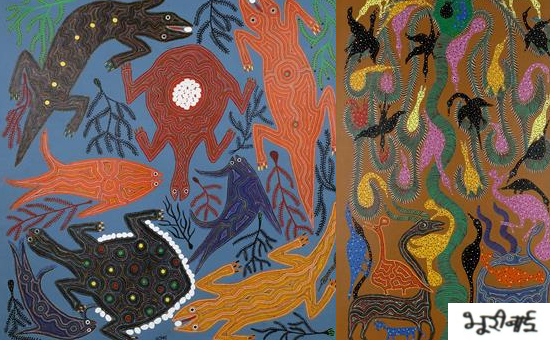 Pic courtesy saffronart.com/artists
Pic courtesy saffronart.com/artists
To read all
articles by author
Purpose of article is to only share information about the wonderful Bhil Art and Bhuri Bai. Photo credits given. The
purpose of this compilation is to document and promote. We have given credits
and reference links in this compilation. In case some are missed, it is not
with malafide intent.